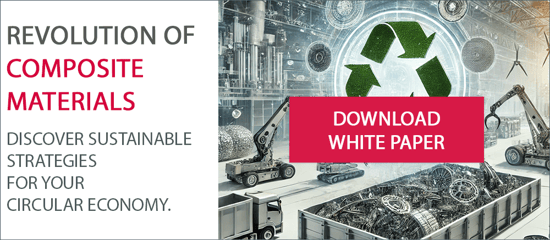The increasing use of composite materials in industry poses new challenges for the circular economy. The reuse of these materials is particularly difficult. However, there is hope: through the intelligent design of components and the development of detachable joining technologies, composite materials can also be used to produce durable and reusable components and thus reduce emissions.
Composite materials: The challenge of the modern circular economy
Composite materials, such as those used in the automotive, aviation and construction industries, offer impressive advantages in terms of strength, weight and durability. However, it is precisely these properties resulting from the combination of different materials that make them difficult to reuse and recycle. The strong bond makes it difficult to separate and reprocess, which in many cases means that these materials end up in landfill or incinerated for energy generation at the end of their life cycle.
The challenge of reuse
In the circular economy, maximizing the use of resources is the ultimate goal. However, this requires solutions that enable the effective reuse and recycling of composite materials. This is the central challenge: how can we design composite structures so that they can be efficiently separated after use and the individual components can be reused?
In traditional construction methods, the connections between the components are only designed for durability, which makes it difficult to separate them at a later date. This problem requires innovative approaches and new technologies that master the challenges of dismantling and recycling.
Detachable connections as the key to sustainability
One of the most promising solutions to this problem is the development of detachable joining technologies. These technologies make it possible to break down composite structures into their individual components after use, which makes recycling much easier. By using such fasteners, materials can be efficiently recycled and reused instead of ending up as waste. 
The white paper "Revolution in composites: Reusable components for a sustainable future" explains in detail how these detachable joints work and which design approaches support disassembly and reuse. It presents various technologies and materials that are already being used successfully in practice to extend the life cycle of products and reduce their environmental impact.
Success stories from the automotive industry
The automotive industry is a pioneer in the use of composite materials and thus also in the development of solutions for their reuse. The white paper presents specific case studies that show how soluble joining technologies have been implemented in vehicles. These examples illustrate not only the technical possibilities, but also the ecological and economic benefits that result.
One particularly impressive example is the development of circular vehicle platforms in which all components can be dismantled and reused at the end of their service life. These platforms are a prime example of how innovative design approaches can put the principles of the circular economy into practice.
Sustainable product design as a competitive advantage
Companies that focus on sustainable product design not only benefit from a better environmental footprint, but also from a clear competitive advantage. Customers and partners are increasingly paying attention to how resource-conserving and sustainable products are manufactured. By implementing detachable connections and other circular design approaches, companies can future-proof their products and differentiate themselves in an increasingly environmentally conscious market.
The next step: sustainable innovation in your company
Would you like to find out more about how you can take advantage of detachable joining technologies and circular design approaches in your company? Our white paper provides you with the information you need to fully exploit the potential of composites in the circular economy. It shows how you can not only reduce emissions through innovative design solutions, but also significantly increase the resource efficiency of your products.
If you would like to find out more about the innovative design of composite materials and their implementation in your company, Stefan Caba, Head of the Sustainable Vehicle Development innovation field, will be happy to provide you with individual advice.
Get deeper insights into the world of reusable composites and the latest developments in the circular economy. Download our full white paper "Composites revolution: Reusable components for a sustainable future" and secure valuable information and practical solutions for your projects. 





